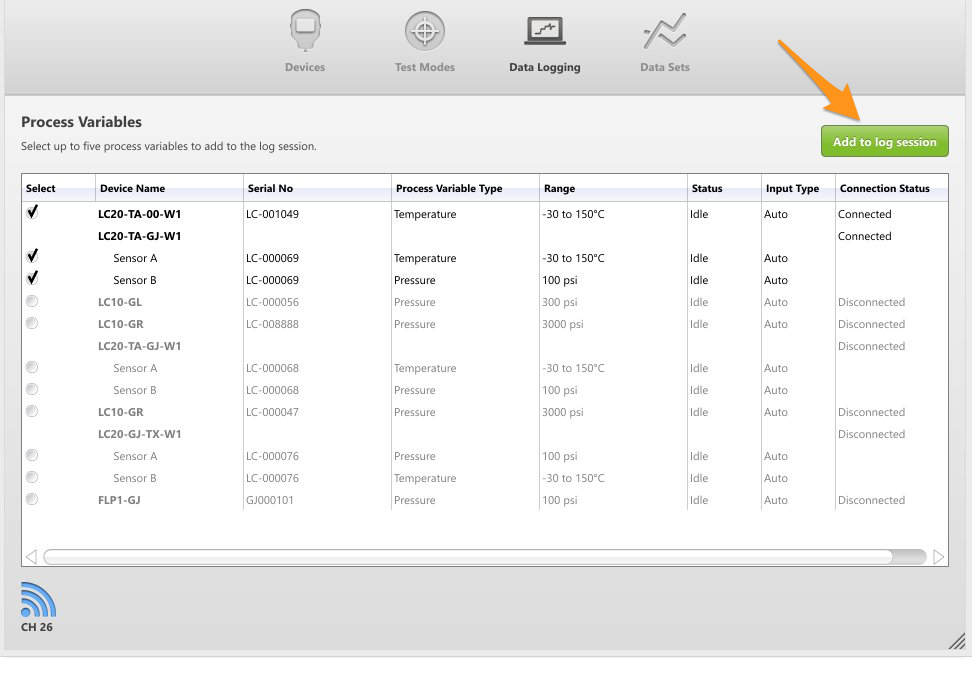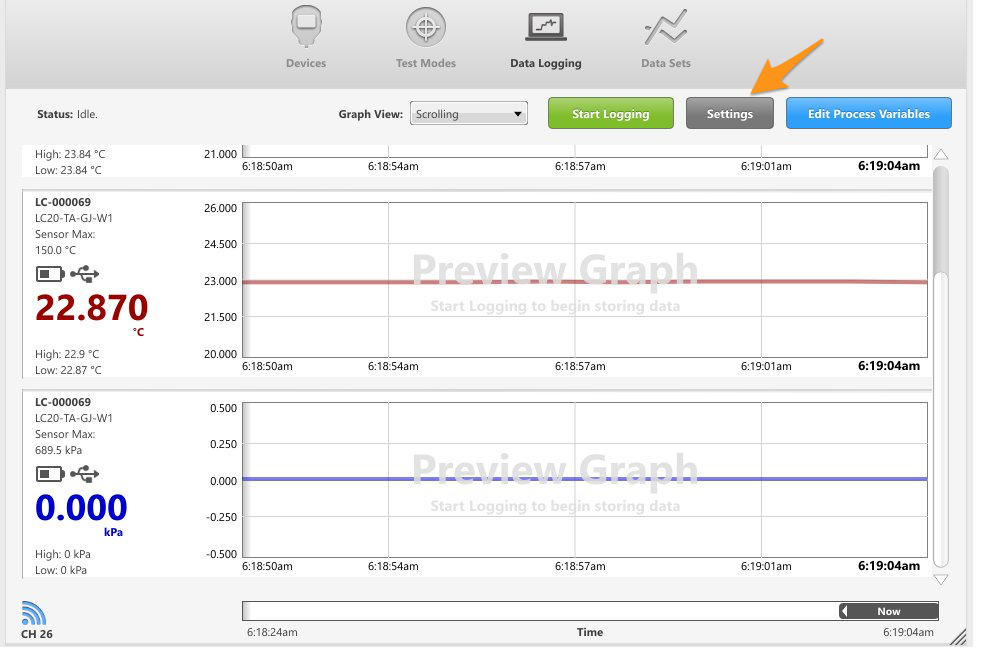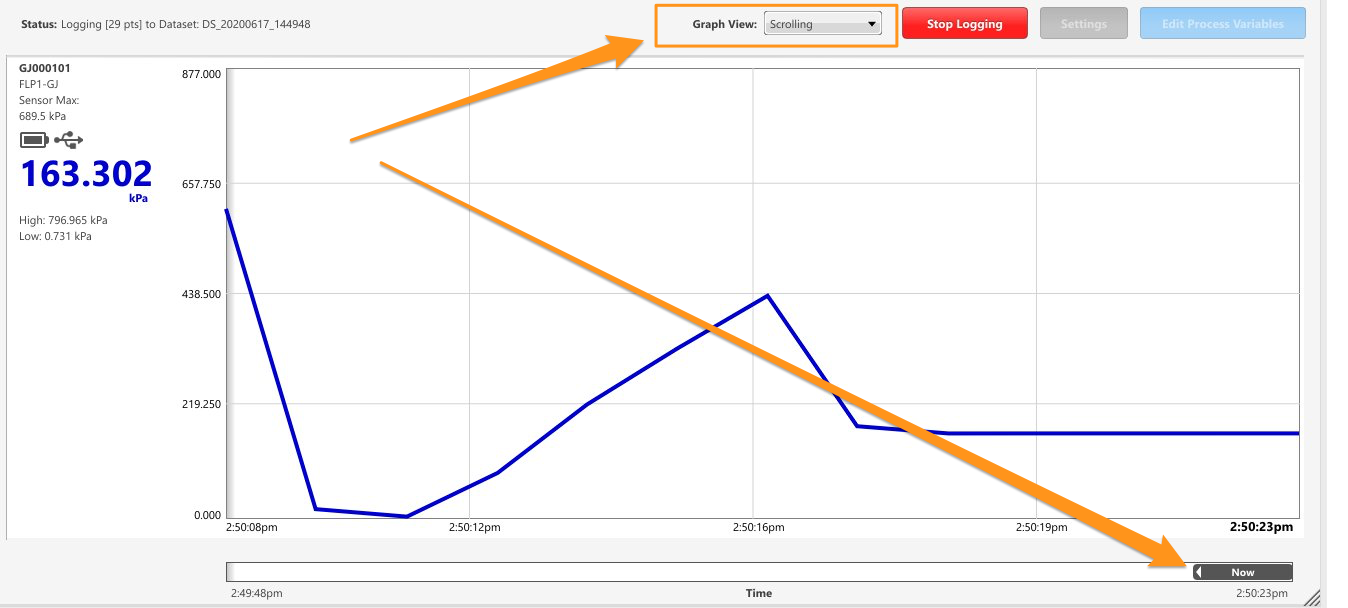Log pressure and/or temperature data to your computer with FieldLab Desktop

This article applies to the following products:
- Field Gauge LC10, all models
- Field Gauge LC20, all models
- Process Meter LC30, all models
- FieldLab Digital Pressure Calibrator, all models.

Things you will need:
- A PC running Windows.
- FieldLab Desktop software version 1.24.7.0 or later installed on your PC. Download the latest version for free.
- A Ralston Instruments Field Gauge, Process Meter, or FieldLab Digital Pressure Calibrator.
- For wired connections: Use the provided USB cord.
- For Bluetooth connections: A Bluetooth-enabled computer and a Ralston gauge with the Bluetooth radio option.
- For Zigbee wireless radio connections: A Zigbee wireless-enabled Ralston gauge and a wireless USB dongle (included with purchase of all Ralston Zigbee wireless-enabled devices).
1. Open FieldLab Desktop on your computer.
2. Power on your Ralston Gauge or Process Meter.
3. Connect your Ralston Gauge to your computer with the provided USB cable or wirelessly.
4. Select Data Logging from the main menu in FieldLab Desktop.

5. Select one or more connected devices, then select Add to Log Session.
In this example we are selecting one LC20 Temperature Gauge, and one LC20 Dual Sensor Field Gauge. We are selecting both the temperature and the pressure sensors for the LC20 dual sensor Field Gauge.
Based on our selections, our log session will save two temperatures, and one pressure.

Optional: Adjust the settings before you start logging
Before you begin your logging session you can adjust the settings for:
- Pressure Units - Choose from any universally accepted engineering unit or Custom Units as defined in FieldLab Desktop.
- Temperature Units - Choose temperature units in °F, °C, °R, or K.
- Session Duration - You can set your log session to automatically stop after a specified length of time, until a total number of points are logged, or use the default; manual stop.

Optional: Use a Custom Pressure Unit
If you have defined a Custom Pressure Unit in your Preferences, then the Custom Unit will appear at the bottom of this list. The Custom Unit does not have to be added to the gauge itself.
Optional: Change the Graph View
Note: You can change the graph view any time during the logging session.
Entire Log
Setting the Graph View selection to "Entire Log" will show all the graph data from the time you started logging.
Scrolling
When you select "Scrolling", only the most recent graph data will be shown, and older graph data will scroll off the left side of the screen as time progresses.
You can use the slider tool at the bottom of the screen to scroll back and view older graph data.

6. Select Start Logging
Once you've confirmed you have the desired settings for the logging session, select Start Logging to begin saving the data from your gauges to your computer.
7. Stop Logging
If you have the Setting for your log session set to Manual Stop, select the Stop Logging button when your session is finished.
If you specified automated stop rules in the settings before beginning your log session, you will not need to select the Stop Logging button and FieldLab Desktop will stop automatically once the stop criteria you specified is met.

All data from your log sessions is saved to Data Sets. You can go to the Data Sets section of FieldLab Desktop to view and export the data from all of your log sessions.

Related Articles
Log pressure and temperature on your computer with one or more Ralston gauges
Log pressure, temperature, and view live graphing from multiple Ralston Gauges on your computer using the FieldLab Desktop software app. Save all readings to one data set. This article applies to the following devices: Field Gauge LC10, all models ...Run a Snapshot Logging (Single-Point Logging) Test on your computer
View and log live single-point pressure readings on your computer, enter any additional metadata your test requires via your keyboard, and save everything to one dataset. These instructions cover how to run a Snapshot Logging Test on your computer ...Create a Snapshot Logging test
Create a Snapshot Logging Test in FieldLab Desktop that you can sync & run on a Ralston FieldLab, or use a FieldLab or Field Gauge connected to your PC and log the data directly to FieldLab Desktop. Things you will need to create the test. A PC ...Delete Data Sets from FieldLab Desktop
You can delete data sets from the FieldLab Pressure, and once they're imported, from the FieldLab Desktop application. 1 Select the Data Sets 2 Select the Delete Icon. 3 Confirm that you'd like to Delete the Data SetCreate a custom Pressure Safety Valve / Pressure Relief Valve Test to run on a FieldLab
Create a new valve test and add it to a FieldLab Pressure Calibrator to perform tests on pressure safety and pressure relief valves. This feature requires: FieldLab Desktop App version 1.24.0 or later installed on your PC. You can update from within ...
Recent Articles
Troubleshoot USB Power Noise Causing Pressure Reading Drift on a Ralston Gauge
Problem Unexpected pressure reading changes on an Ralston LC gauge when connected via USB. Root Cause Electrical noise is introduced through a low-quality USB hub and power supply interference. Noise from switch-mode power supplies (SMPS) can travel ...Adjust Damping on your Ralston Gauge
Damping slows the visual updates of a pressure gauge’s reading. The goal is to minimize minor fluctuations of the pressure reading on the screen caused by subtle variations in pressure that may create unwanted visual noise. Ralston gauges are set to ...Register your Ralston Gauge
Register your Ralston gauge to access calibration certificates and install firmware updates. This article applies to: FieldLab, Field Gauge LC10, LC20, and Process Meter LC30, all models. Things you will need: A PC running Windows. FieldLab Desktop ...Look Up Lead Time and Pricing for a Ralston Product
Go to ralstoninst.com Sign in to your Ralston account Select "Look Up Pricing and Lead Time by Model Number" Enter the model number of the Ralston product View the search results For each model number in your search results, info will be provided ...Download Current Price List
Get current pricing for all Ralston products Price lists are available in PDF, XLS, and CSV formats. All file formats include the following fields: Product Family (e.g. "NPT Male Quick-test Adapters) Part Number (e.g. "QTHA-2MS1") Description MSRP ...